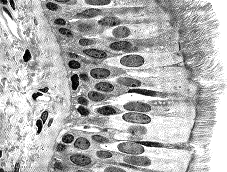The type of tissue illustrated in the accompanying figure is:

a. elastic connective tissue.
b. simple squamous epithelium.
c. pseudostratified epithelium.
d. cartilage.
e. adipose tissue
c
You might also like to view...
During chemical evolution, which of the following occurred in the molecules involved?
A) Entropy decreased while potential energy increased. B) Entropy increased while potential energy increased. C) Entropy stayed constant while potential energy increased.
The disease anthrax is caused by the pathogenic bacterium ________, which produces heat-resistant structures known as ________
A) Azotobacter chroococcum / endospores B) Azotobacter chroococcum / plasmids C) Bacillus anthracis / endospores D) Bacillus anthracis / plasmids
To determine the specific growth rate of a bacterial population, it is essential to know
A) cell concentrations at varied time points. B) total number of cells in the population at varied time points. C) cell concentrations at varied time points or the generation time. D) turbidity measurements and the total number of cells in the population at varied time points.
You are working as a marine biologist off the coast of Mexico. While observing organisms in a tidepool, you find a dramatically colored animal that has not been classified before. Your observations lead you to think that this beautiful animal is apparently a nudibranch, which is a member of the mollusk phylum. However, you are puzzled by one feature that does not fit with the other anatomical and
physiological features of mollusks: stinging nematocysts in the external projections on the back of this animal. Explain how this animal might be correctly classified and what the supporting logic is. What will be an ideal response?